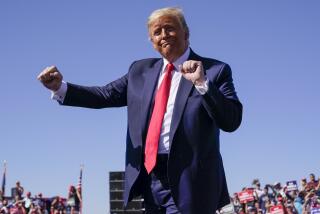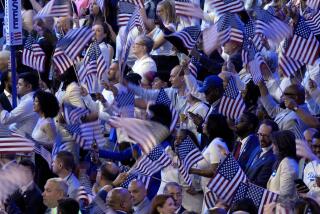Patriotic Songs Rousing Extra Emotion This Fourth of July
- Share via
“A patriotic song is an emotion,” the great songwriter Irving Berlin once said. “And you must not embarrass an audience with it or they will hate your guts.”
The history of patriotic music in the United States predates the birth of the nation, so it’s no surprise that the thread that ties together the most enduring of American songs is sentiment, rather than a particular musical characteristic.
“Emotion is the one classic trait of all music,” says Al McCree, owner and CEO of Altissimo! Recordings, a label that produces and distributes music from United States military bands. “A classic patriotic song somehow brings about a strong love of country.”
Traditionally, songs such as “Stars and Stripes Forever,” “Yankee Doodle,” “God Bless America,” and “America the Beautiful” primarily are heard around the Fourth of July. But the attacks of Sept. 11 have brought concepts of patriotism and heroism to the fore and placed new focus on music that can rouse such feelings.
Although these songs come out in times of crisis, they aren’t always written that way. John Philip Sousa, for instance, composed “Stars and Stripes Forever” aboard a ship on his way back from Europe. Others were written with the intent of stoking the national spirit.
“They tend to take on, through association, the mood of the people or a patriotic spirit in times of crisis,” says Deane Root, director of the Center of American Music and professor at the University of Pittsburgh. “Take Irving Berlin’s ‘God Bless America,’ which he wrote about 20 years before World War II. He had to touch it up for the needs of the moment once the United States was entering the war. That song, more than any other, symbolizes the wartime spirit in the 20th century.”
Lyrically, the songs usually look beyond flesh and blood for strength.
“They’re calling up a higher power, a higher right than can be imposed by human government,” says Root.
The first U.S. patriotic song might have been “The Liberty Song,” written by John Dickinson in 1768 (the same year it was published in Boston newspapers). Sung throughout the colonies at political meetings, dinners and celebrations, the song was the first to use the phrase “by uniting we stand, by dividing we fall.” Dickinson wrote the lyrics to fit the music of the anthem of the British Royal Navy, “Hearts of Oak.”
The U.S. national anthem, “The Star Spangled Banner,” was designated as such by Congress in 1931, but was written by Francis Scott Key during the War of 1812.
In September 1814, Key and a friend were trapped on a boat and watched the British bombardment of Fort McHenry, which guarded Baltimore. For the melody, Key used the English song, “To Anacreon in Heaven.” The song was popular in Baltimore but didn’t become a national song until the Civil War.
The Civil War produced some of the country’s most enduring songs, and demonstrates how great American music is written with or without crisis in mind. “Dixie,” written by Daniel D. Emmett in 1859 for a minstrel show, became the rallying cry of the Confederates. The Union troops’ call to arms, “Battle Hymn of the Republic,” was written by Julia Ward Howe on a trip to a Union camp. She scribbled the words down to the music of “John Brown’s Body.”
Like Irving Berlin’s “God Bless America,” “America the Beautiful” was written during peace time. Katherine Lee Bates, a professor of English literature, wrote it on an 1893 trip to Pike’s Peak. George M. Cohan, like Berlin, was a popular songwriter whose efforts hit a nerve with the public during wartime. He wrote “You’re a Grand Old Flag,” “I’m a Yankee Doodle Dandy” and “Over There,” a theme of World War I.
“Music can be arousing for sure,” says Jerome Sehulster, professor of psychology at the University of Connecticut. “The rhythms of a march tend to be bright sounds, they tend to use brass, they tend to be inspiring and if you’re marching, you can keep step to it.”
The Vietnam War was the first American war that produced more protest songs than patriotic ones, for a variety of reasons.
“What coincides with Vietnam is the civil rights movement and the folk movement,” says Purchase College’s Allyson Bellink.
“You have folk music burgeoning in one of many of its rebirths, so that same recycling is going on,” she continues. “During Vietnam we had an interesting period where people were composing folk music, which is an oxymoron. It was using the same instruments but the lyrics were frequently original, drawing from the blues, Woody Guthrie and Negro spirituals. Rock music of the late 1960s was continuing along the lines of the modern folk music.”
The events of Sept. 11 brought on a wave of patriotism perhaps not seen since World War II. In the wake came music to accompany confusing times. Tribute concerts came with lots of veteran rockers no longer serving the counterculture but the establishment.
Whether any of the songs associated with Sept. 11 come to be historically attached to that day’s events isn’t clear, though many music experts believe they won’t.
It was clear, however, that country music provided the most poignant statements after the terrorist attacks. Lee Greenwood’s 1984 hit, “God Bless the U.S.A.,” nearly replaced the national anthem in the weeks following the collapse of the World Trade Center. And Alan Jackson saw massive success with “Where Were You (When the World Stopped Turning).”
*
Ray Hogan is a reporter for the Stamford Advocate in Connecticut, a Tribune company.
More to Read
The biggest entertainment stories
Get our big stories about Hollywood, film, television, music, arts, culture and more right in your inbox as soon as they publish.
You may occasionally receive promotional content from the Los Angeles Times.










